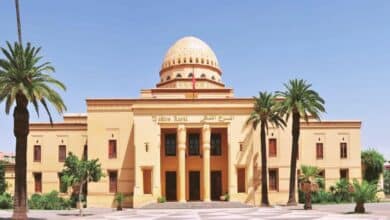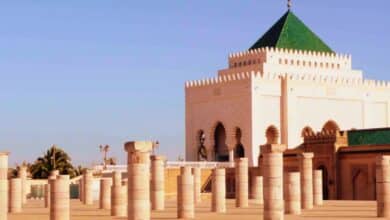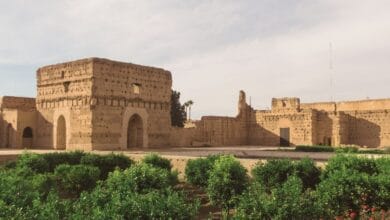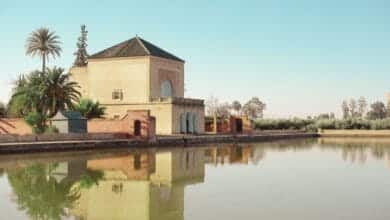
Discover the Heritage Sites in Morocco
Do you know that the medina of Fez is very large? It covers 280 hectares, making it one of the largest in the world. Since October 28, 1975, Morocco has protected its heritage by registering it with UNESCO. Today, the country can boast of 9 world heritage sites. These sites bear witness to the rich history and cultural diversity of Morocco.
When we explore the cultural heritage of Morocco, we discover a mixture of different cultures and eras. This mix is seen through impressive sites and unique traditions. For example, the Ksar of Aït-Ben-Haddou, which became a UNESCO site in 1987, and the medina of Marrakech, recognized in 1985. These places reflect the depth of Moroccan history and culture, attracting visitors from all over the world.
The Medina of Fez
The medina of Fez was founded in the 9th century. It is a cultural and historical treasure recognized in the heritage sites in Morocco . At the time of the Merinids, in the 13th and 14th centuries, Fez shone. It was then the capital of the kingdom, surpassing Marrakech. The important historical elements of the region come from this period of glory.
As a religious, cultural and learning center, Fez is special. Here is the oldest university in the world, established in the 9th century. The medina, along with Fez El-Bali and Fez Jédid, is considered very valuable and well preserved. It is among the largest and preserved in the Arab-Muslim world.
In 1981, the medina of Fez became a UNESCO world heritage site . It shows a prosperous city between the 12th and 15th centuries in the Mediterranean. Fez has left traces in the architecture of North Africa, Andalusia, and sub-Saharan Africa.
Even though Rabat became the political capital in 1912, Fez remained a cultural and spiritual pillar. It has kept its identity, despite the changes of the modern world.
The structure of the medina has remained almost the same thanks to careful planning and efforts to prevent house collapses. A protection program, led by the Agency for the Densification and Rehabilitation of the Medina of Fez, is in place. This program, in collaboration with the Ministry of Culture, maintains the medina as a jewel of heritage in Morocco.
The Archaeological Site of Volubilis
The archaeological site of Volubilis has been a UNESCO world heritage gem since 1997. It is important for Moroccan cultural tourism . This place covers 42 hectares. It was inhabited for ten centuries.
With its mosaics and statues, Volubilis has a great artistic treasure. There are works in marble and bronze. Several thousand inscriptions were discovered there.
The different styles of architecture tell the rich history of Volubilis. From the Mauritanian period to the Islamic period, each era has left its mark. This shows the development and creativity of the region.
The Roman rampart built between 168-169 is an important testimony to Roman heritage. It shows the forums and thermal baths of the time.
Volubilis is a cultural melting pot. Mediterranean, Berber, or even Christian, the cultures are numerous. Conservation actions are being carried out to protect the site. This includes laws and safety measures.
Volubilis also has a buffer zone of 4,200 hectares. It is a key UNESCO World Heritage Site. It attracts visitors from all walks of life. Thus, it promotes Moroccan cultural tourism .
The Medina of Marrakech
The historic medina of Marrakech was founded by the Almoravids over a thousand years ago. It is a living heart of Moroccan history. This place shows how rich the city is in culture and architecture. In 1985, UNESCO recognized it as a world heritage site. The medina covers a vast area of 700 hectares.
Famous buildings, such as the Koutoubia Mosque and its 77 meters high, show the importance of Marrakech. There is also the Ben Youssef Madrasa and the Saadian tombs. These places tell the history of Marrakech. Jamaâ El Fna Square is a magical place filled with shows and life.
The analysis of Morocco’s heritage sites, including the medina of Marrakech, offers an informed view. It highlights places rich in culture and history in the country:
| Site | Year of registration | Features |
|---|---|---|
| Medina of Fez | 1981 | Oldest medina, cultural and university center. |
| Medina of Marrakech | 1985 | Mosques, souks, Jamaâ El Fna square, historical monuments. |
| Ksar of Ait Ben Haddou | 1987 | Clay fortification, Hollywood films. |
| Historic City of Meknes | 1996 | Islamic and European architecture. |
| Volubilis Archaeological Site | 1997 | Well-preserved Roman ruins. |
The Medina of Marrakech is a cultural treasure and a tourist magnet. It receives millions of visitors from all over the world. This helps preserve its history and heritage. To keep this place special, protection rules have been put in place. For example, there is an Architectural Charter for the Medina of Marrakech. And Law 22-80 on heritage also contributes to this. These regulations help maintain the authenticity of the site despite its urban development.
By exploring the medina, we delve into the cultural heritage of Morocco. This is an opportunity to discover the vibrant history and traditions of Marrakech.
The Historic City of Meknes
Meknes is nicknamed “the city of a hundred minarets”. It is part of the UNESCO world heritage . The Almoravids founded it in the 11th century. Meknes became capital in the 17th century under Sultan Moulay Ismaïl. He made it magnificent, mixing Hispano-Moorish styles.
The Medina of Meknes fuses Islamic and European architecture. This reflects the Maghreb of the 17th century . The city walls, 15 meters high, are impressive. There are beautiful doors there, such as Bab Mansour.
Among the historic sites of Morocco , Meknes shines with its variety. The city has twenty-five mosques, ten hammams and palaces. There are also large grain silos and hotels for merchants. These buildings come from the Almoravid, Merinid and Alawite periods.
In 2014, Meknes had 632,079 inhabitants. Its population density is 1,708 inhabitants per square kilometer. It makes it the sixth largest city in Morocco. In 1996, its Medina became a UNESCO World Heritage Site. This shows its historical role and remarkable architecture.
The Medina of Tetouan
The medina of Tetouan is very special in Morocco. It is famous for its beauty and rich history. It is found on the slopes of Jebel Dersa, offering beautiful views. Tetouan was placed on the world heritage list in 1997. This shows how cultures, such as those of Morocco and Andalusia, can influence each other.
Despite its small size, the medina is impressive. It is often considered the best preserved of Moroccan medinas. Its blend of Moroccan and Andalusian cultures is visible everywhere. The medina is surrounded by a 5 kilometer wall with seven large gates.
In the medina, there are streets, squares, and even old buildings. There are also special areas for artisans and traders. Places like the École des Arts et Métiers make the city famous for its traditional art. These centers help preserve artistic techniques from the past.
Protecting this UNESCO site is very important. Morocco has strong laws for preservation. Local authorities work together with culture to keep the city authentic.
Plans were made to keep the medina beautiful and important. These plans want to maintain its value while helping local development.
The Ksar of Ait Ben Haddou
The Ksar of Ait Ben Haddou is located in Morocco, in the Ouarzazate region. It is a magnificent example of pre-Saharan architecture. In 1987, UNESCO added it to the World Heritage List. This unique site shows how the inhabitants of Morocco built to protect themselves.
Built in the 11th century, this ksar is an ancient treasure. It has survived to this day thanks to ancient techniques and materials like rammed earth. It is marked by a beautiful combination of wood and clay. Its coordinates are 31° 02′ 50″ north, 7° 07′ 44″ west.
This ksar has houses and buildings surrounded by high walls. There is a mosque, a square, and areas for processing cereals. There are also special places like defense towers, a granary, and even graveyards.
The Ksar of Ait Ben Haddou is famous for having been a film shooting location. Global films like Lawrence of Arabia , Gladiator , and Game of Thrones have been filmed here. Its history, culture, and cinema make it a place loved by many.
It covers 3.03 hectares, with 16 hectares of buffer zone. This ksar perfectly shows the traditional architecture of southern Morocco. It was an important trading point, connecting many places for centuries.
Even with all the changes, the Ksar of Ait Ben Haddou remains true to itself. Its unique style is a perfect blend of pre-Sahara architecture.
The Medina of Essaouira
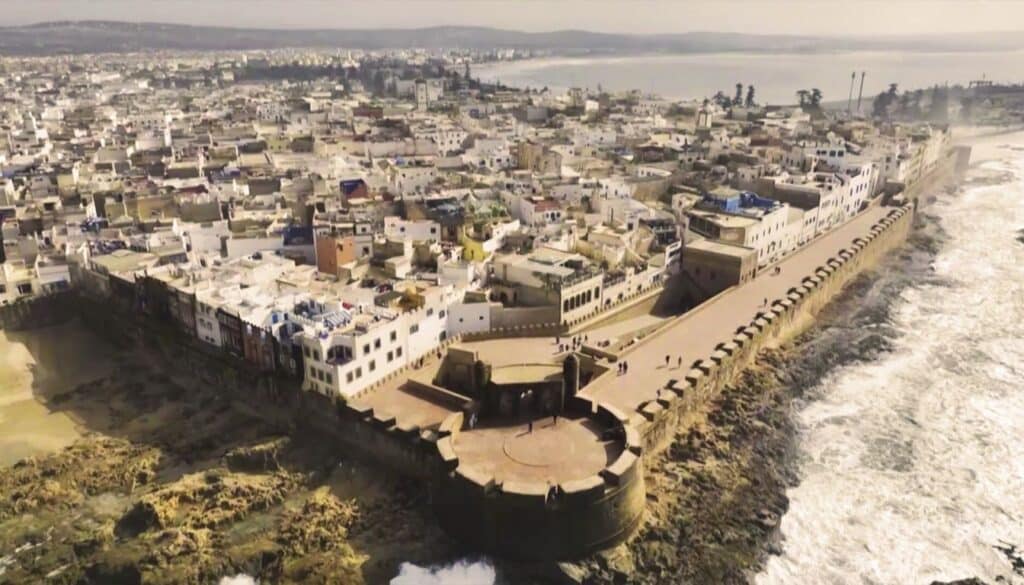
Essaouira , formerly Mogador, is a coastal city fortified by the Atlantic. It has been a UNESCO World Heritage Site since 2001 . The place mixes European military architecture and Arab-Muslim urban planning. It is located at 31° 31′ 00″ north, 9° 46′ 09″ west.
This medina extends over 30 hectares, with a buffer zone of 15 hectares. It is an exceptional example of a fortified town dating from the 18th century. Its construction began in 1764, under the Alaouite Sultan Sidi Mohammed Ben Abdellah. He mixed European architecture with a North African style. Essaouira is surrounded by Vauban fortifications, and has monumental gates, including the Bab Marrakech Bastion.
The city has preserved its architecture through the use of local materials and traditional methods. Several groups, such as the state and private cooperatives, strive to maintain this authenticity.
Essaouira is also known for its diversity, bringing together Amazighs, Arabs, Europeans, and Africans. The collaboration of these cultures is seen in the architecture and urban planning of the city.
In addition to its rich history, Essaouira is an important fishing port. With around 70,000 inhabitants, the city attracts many tourists. It is also twinned with Saint-Malo, La Rochelle in France, and Etterbeek in Belgium, illustrating its role as a link between Morocco and Europe.
| Key Information | Details |
|---|---|
| Area of the Medina | 30 hectares |
| Buffer | 15 hectares |
| Population | Around 70,000 inhabitants |
| Contact details | 31° 31′ 00″ north, 9° 46′ 09″ west |
| UNESCO classification | December 14, 2001 |
| UNESCO Identification Number | 753 |
| Architectural style | Mix of European military design and Arab-Muslim architecture |
Essaouira is a living part of Moroccan heritage and culture. It is appreciated throughout the world for its uniqueness and its preservation.
The Portuguese City of El Jadida
El Jadida was called Mazagan by the Portuguese from 1502. It is a jewel of Portuguese architecture in Morocco. Since 2004, its site has been listed as a UNESCO World Heritage Site.
From 1514 to 1769, the Portuguese shaped this city. Their presence is still visible in the bastions and a Manueline Gothic church. These structures mix local style with that of Portugal.
El Jadida is located one hour and twenty minutes from Casablanca. It is three hours from Marrakech. The explosion of the bastions upon their departure earned it the nickname “The Ruined”. The help of Sultan Moulay Abd ar-Rahman in the 19th century allowed the city to be rebuilt. Thus, a multicultural society emerged.
Today, the Port of Mazagan is crucial to the local economy. It is an essential point for fishing and water sports. The city is also recognized for its role in Moroccan cinema, hosting numerous festivals.
At El Jadida , visitors can admire European architecture mixed with Moroccan tradition. The city is also known for the Hassan II Park, a green space in the middle of urbanization. Finally, its fortifications show the military know-how of the Renaissance.
Here are some essential facts about El Jadida:
The Historic Center of Rabat
Rabat is an important city for culture. It is a fine example of the ancient Arab-Muslim mixture and Western modernity. Many of its places are recognized by UNESCO.
The historic center has unique places. Like the Kasbah des Oudayas for its defensive walls. There is also the Chellah Necropolis, combining Roman and Islamic history. The famous Hassan Tower shows the importance of the Almohads here.
In the early 1900s, under the French Protectorate, Rabat began to change. This lasted from 1912 until the 1930s. This was a large project that added public spaces and new health ideas.
- Urban diversity: Rabat has different neighborhoods, each with its own charm, such as the historic medina or the qasba.
- Architectural elements: We can see witnesses of history in its architecture. Each element tells a story.
- Authenticity: Rabat represents its mix of ancient and modern well. Its buildings tell its living history.
In 2020-2021, Rabat is the African capital of culture. This shows how important the city is to the history and urban planning of Morocco. Rabat highlights the importance of preserving UNESCO heritage.
Rabat is particularly beautiful for its mix of history and new ideas. This rare combination makes the city special. It shows how architecture, traditions and development can come together.
Moussems and Festivals
Festivals and moussems are important events in Morocco. They highlight the beautiful traditions of the country. Among them, the Tan-Tan Moussem and the Sefrou Cherry Festival are very popular. They attract large crowds, coming from all over to visit them. These festivities play a big role in preserving Moroccan culture and its history.
Tan-Tan Moussem
The Tan-Tan Moussem is a key event, particularly in May. He sees the influx of thousands of people from everywhere. Nomadic tribes come together to celebrate their culture. There is music, dance and traditional tales.
The festival also offers demonstrations of fantasia . This equestrian tradition is a feast for the eyes. Local markets add an authentic touch to this experience. This event is even classified as a UNESCO world heritage site.
The Cherry Festival in Sefrou
Every June, the Sefrou Cherry Festival highlights the delicious cherry harvest. This event celebrates beauty and fertility with the election of the Cherry Queen. Festivities include musical performances and parades.
There are also local stalls where you can buy handicrafts. This festival is very popular, attracting people from all over. This helps to make the city of Sefrou known to a wider audience.
Morocco has many other festivals and moussems. They offer a wide variety of local arts and cultural activities. For example, Sidi Ahmed Ou Moussa in August is crucial in the Souss Massa region.
In March, the Lalla Taalat Moussem enlivens the town of Taalat. It is known for its large market and unique ceremonies. The Draa-Tafilalet also organizes memorable parties. Like the Rose Festival in May and the Khamlia Moussem in August, centered on Gnaoua music and charity.
Here’s a look at some notable events in the area:
| Event | Region | Period | Activities |
|---|---|---|---|
| Moussem of Tan-Tan | Tan-Tan | May | Songs, dances, fantasia, trade fairs |
| Cherry Festival | Sefrou | June | Election of the Queen, music performances, parades |
| Sidi Ahmed Ou Moussa | Souss Massa | August | Rituals, fairs, cultural performances |
| Moussem by Lalla Taalat | Taalat | March | Market, traditional ceremonies |
| Rose Festival | M’Goun | May | Parades, watering of petals |
Intangible Cultural Heritage
Morocco has great wealth in intangible heritage . Ancient traditions show the deep culture of the country. In 2023, Morocco has 14 elements classified by UNESCO. This includes 13 on the list and one in urgent need of protection. These facts highlight why it is vital to protect and promote these special practices.
The Mastery of Argan
Mastery of argan is a know-how passed down from generation to generation. These are argan nuts, a tree from southwest Morocco. These nuts produce a rich oil, good for health and skin. The tradition also includes preserving the environment and supporting women’s cooperatives.
Falconry
Moroccan falconry is a magnificent art with a rich history. It’s more than a sport. It teaches values such as friendship, sharing and respect for nature. This practice is inherited from the family, highlighting patience and the strong bond between man and bird. It is a living example of the harmony between humans and nature.
Morocco has strongly supported the safeguarding of intangible heritage since 2006. In 2022, he headed the UNESCO Committee for Intangible Heritage . This role shows his dedication to protecting and promoting his intangible culture. Famous practices such as the Mediterranean diet and knowledge of the date palm are recognized. Each of these traditions helps form a distinctive and vibrant Moroccan culture.
The Smiles of Moroccan Hospitality
Morocco is known for its warm welcome, often described as Moroccan hospitality . This is seen everywhere, especially in food. The Mediterranean diet is very popular there for its variety and balance.
The dishes are prepared with fresh, local ingredients. These delicious meals are more than just food. They represent the spirit of conviviality and sharing.
The Mediterranean Diet
The Mediterranean diet in Morocco includes fresh vegetables, olive oil, dried fruits and cereals. This type of meal is excellent for your health. It also shows Moroccan culinary craftsmanship.
Eating a meal together strengthens bonds. This also demonstrates Moroccan hospitality .
The Cultural Space of Jemaa El Fna Square
Cultural life in Marrakech revolves around the Jemaa El Fna Square . It’s a lively place, with no dull moments. It is listed as a cultural heritage site for its storytelling, music and arts shows.
Walking there is like entering real Moroccan life. The spirit of hospitality is everywhere, welcoming visitors.
Every time we share a meal or visit Jemaa El Fna Square , we discover something beautiful. Moroccan hospitality is fully revealed, showing its magnificence.
Heritage Sites in Morocco
The heritage sites in Morocco are rich in stories that show the evolution of this country. Since 1975, Morocco has been committed to preserving its cultural heritage with UNESCO. Nine places important to their culture are on the list.
The Medina of Fez led the way in 1981 by becoming a World Heritage Site. Founded in the 9th century, it remains among the oldest and best maintained in the Muslim world. Marrakech, a well-known city, shines with its monuments such as the Koutoubia Mosque and the Jemaa el-Fnaa square.
An important gem is Volubilis, an ancient Roman city dating from the 3rd century BC. Listed by UNESCO in 1997, it shows the greatness of Roman know-how. Its forums and thermal baths are incredible testimonies.
Morocco also offers treasures like the Ksar of Ait Ben Haddou and Meknes. The first, an adobe castle, joined the UNESCO list in 1987. Meknes seduces with its mix of Islamic and European architecture.
Historical Vestiges Across Morocco
Morocco is a true mix of cultures, with sites that show the heritage of the Romans and Arabs. These places attract a lot of visitors who love culture. They come from all over the world.
Roman and Arab influences
Volubilis, a Roman site, is a good example. It is an ancient city of 42 hectares, founded in the 3rd century BC. It is a UNESCO heritage site. There are beautiful mosaics and statues there. The Hassan II Mosque in Casablanca shows Arab influence, is very large, and has a 200 meter minaret.
Sites from North to South
From north to south, remains can be found everywhere in Morocco. To the north, there is the kasbah of Chefchaouen which dates from the 15th century. It offers a museum showing local crafts. Marrakech, in the center, has the El Badi Palace, from the 16th century. Even in ruins, it remains beautiful and is a world heritage site. Further south, the Ksar of Ait Ben Haddou, near Ouarzazate, shows ancient architecture.
“Morocco is a crossroads of cultures, where each vestige tells a unique story of influences and exchanges. »
Moroccan archaeological sites fascinate history lovers. They show how Roman and Arab cultures left their mark. This makes the cultural trip to Morocco unique and enriching.
Conclusion
We saw treasures while traveling through Morocco’s heritage. We discovered how the past and the present intertwine. Morocco has nine sites inscribed on the UNESCO World Heritage List. These sites range from the Medina of Marrakech, rich in almost 1000 years of history, to the 16th century Portuguese City of Mazagan.
Moroccan cultural heritage is vast. It is not limited to buildings, also including rich and unique traditions. Marrakech with its Jemaa el-Fna Square, its art of falconry, and argan shows this diversity. Morocco also offers around 17,000 prehistoric rock-art sites. This rich past allows you to delve into a history spanning thousands of years.
Moroccan heritage is alive. It shows how craft traditions evolve. These professions employ more than 2 million people. Carpets and ceramics are the most notable exports. They reflect the heart of Moroccan artisanal creation.
Visiting Morocco also means immersing yourself in its current culture. This is done by visiting its sites and taking part in its festivals. Thus, everyone discovers the true depth of the nation. The country inspires with its craftsmanship and its commitment to the future. Morocco offers a unique and memorable cultural trip for anyone looking to learn more.

